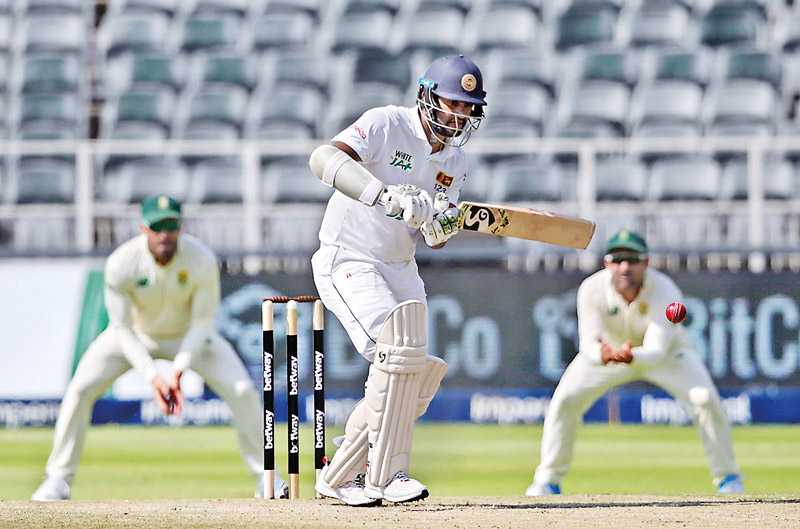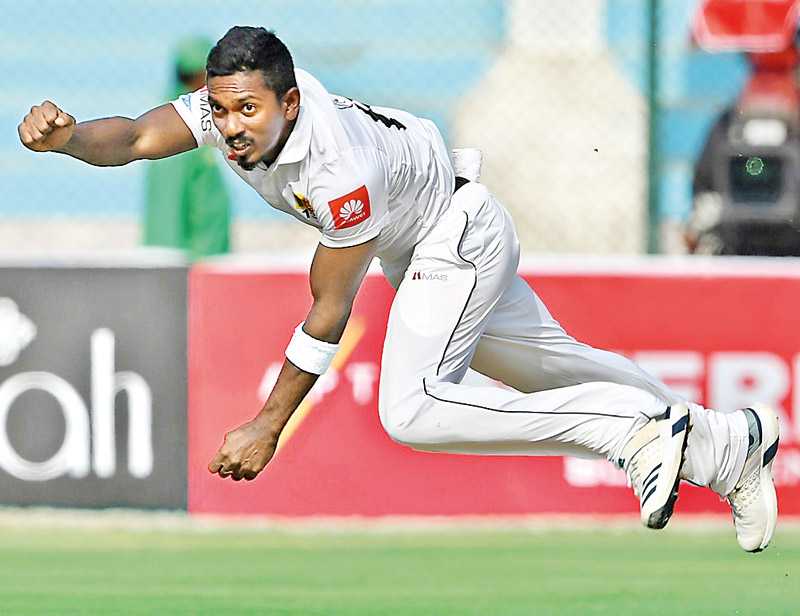Friday Jan 17, 2025
Friday Jan 17, 2025
Thursday, 7 January 2021 00:05 - - {{hitsCtrl.values.hits}}

Dimuth Karunaratne led Sri Lanka from the front with a century in the second Test against South Africa at Johannesburg and was the only centurion for his team in the series
By Sa’adi Thawfeeq
Sri Lanka’s two-Test tour of South Africa could be viewed in two different phases – one, that the series would have been more competitive had not injuries hit some of the key players, and two, how difficult it was to come and play five-day Test cricket after being in isolation for 11 months due to the current COVID-19 pandemic.
From the outset Sri Lanka knew that touring South Africa and playing under their conditions was not going to be a walk in the park. For one, South Africa were seething to extract revenge on them for their 2-0 defeat suffered in the last series played in 2019, and the hosts ensured that on this occasion Sri Lanka would not get the pitches that would assist them, but one that would favour their fast bowlers.
Prior to the commencement of the series South Africa’s newly appointed Test captain wicketkeeper/batsman Quinton de Kock said: “Against Sri Lanka we have a lot to rectify. They came here and beat us in our own grounds. We want to rectify that and win the series convincingly which we hope will happen.”
And convincingly they did beat Sri Lanka – by an innings and 45 runs in the first Test at the Centurion and by ten wickets in the second Test at Johannesburg – to gain sweet revenge.
Chief Selector Ashantha de Mel who accompanied the Sri Lanka team to South Africa said that mental toughness will play a big role in how successful they would be in the Test series, and in this aspect Sri Lanka failed.
What the series revealed was that the Sri Lankan batsmen were not up to the mark mentally to tackle the high-class bowling attack that South Africa possessed, even though it was quite inexperienced with Lungi Ngidi, Anrich Nortje and Wiaan Mulder having played not more than 12 Tests amongst them, and Lutho Sipamla making his debut. There were moments that Sri Lanka looked like dominating the bowling, but they could not do it for a long period of time consistently.
Skipper Dimuth Karunaratne said prior to the start of the series that the team that bats well will hold the key to winning it and so it proved. South Africa showed that they were the better side by running up scores of 621 and 302 – totals that were sufficient to allow their quartet of fast bowlers to bowl Sri Lanka out twice.
Sri Lanka began the series on a promising note by posting their highest-ever total in South Africa – 396. It could have been more had not Dhananjaya de Silva, who was batting so exquisitely on 79 and had got the measure of the bowling, been forced to retire hurt after suffering a grade 2 muscle tear in his thigh. Sri Lanka not only lost a quality batsman, but also his wicket-taking offbreaks.
When South Africa went to bat Sri Lanka saw their world starting to fall apart, as one by one their bowlers began to get injured. For starters they began the series on the back foot when the spearhead of their bowling attack, and most experienced bowler, Suranga Lakmal, was side-lined by a hamstring injury sustained during practice. Then, during the course of the first Test, their bowling resources gradually began to deplete.
In addition to the loss of De Silva, fast bowlers Kasun Rajitha and Lahiru Kumara both limped off the field with groin injuries, further diminishing the bowling attack. Their injuries put an extra strain on the rest of the bowling unit, and in this aspect Vishwa Fernando, Dasun Shanaka and debutant Wanindu Hasaranga were forced to bowl out of their skin, sending down 105 of the 142.1 overs bowled in the innings.
South Africa cashed in on this handsomely to post their highest total against Sri Lanka – 621 – surpassing the previous highest of 580-4 declared at Cape Town in 2012. Further disaster was to follow during Sri Lanka’s second innings when their most experienced batter and top scorer in the first innings with 85, Dinesh Chandimal, joined the growing list of casualties when he pulled up with a groin injury while batting.
Thus, Sri Lanka had to draw from their reserve bank for the second Test to replace those injured. They gave a Test cap to wicketkeeper/batsman Minod Bhanuka and fast bowler Asitha Fernando, making them the 152nd and 153rd Test cricketers to represent the country.
While Bhanuka failed to deliver being dismissed for 5 and 1, Fernando at least impressed with his pace and variation picking up two wickets and proved an ideal foil to left-armer Vishwa Fernando, who once again displayed his flair on South African surfaces taking his first five-for in a Test innings. On the triumphant 2019 tour he was Sri Lanka’s leading wicket-taker with 12 wickets in the series at 18.91, and on this occasion too he was the leader of the pack with eight wickets at 31.62.
After what seemed an endless drought skipper Dimuth Karunaratne also finally scored a Test hundred. The last one was made in August 2019 against New Zealand at Galle, but in the intervening 17 months he played in only six Tests. It was a courageous knock as he batted with an injured right thumb, later to be diagnosed as a hairline fracture.
What Sri Lanka lacked was big partnerships to build their innings. The only one that took shape and looked threatening was between Chandimal and Dhananjaya de Silva in the first innings of the first Test. The partnership was flourishing at 131 when De Silva retired hurt, thus breaking any momentum.
South Africa also ensured that there would be no repetition of the heroics performed by Kusal Perera during the 2019 series when he almost single-handedly carried Sri Lanka to a famous one-wicket win at Durban. The bowlers didn’t feed him with balls for him to cut, drive and hit off his legs – which are his strong points – and reduced his run scoring down to just two fifties in four innings.
Most disappointing was the form displayed by one of Sri Lanka’s top order batter Kusal Mendis, who after scoring 12 in the first innings of the first Test suffered the ignominy of being dismissed for three successive ducks in his next three innings. Whether it is a mental or technical problem, Mendis will have to go back to the drawing board and sort it out, for he is too good a player to be left out.
Regardless of the results obtained in South Africa, however unsatisfactory it may be, the Lankan cricketers are at least going into another two-Test series at home against England starting 14 January in Galle having played a full Test series.
De Mel said: “If we do well in South Africa, we come back positive. If you get a massacring, then you will come back bruised and low in confidence – it’s up to the players.”
Sri Lanka were totally outplayed in South Africa and whether they can turn it around in the series against England depends on how soon they can recover from the scars that have been inflicted on them.
England’s spearhead James Anderson believes that Sri Lanka has a “slight edge” going into the Test series because England have not played any red-ball cricket since August, while their preparation for the series has been “not ideal”.
In recent years Sri Lanka has lost that edge of what you call home advantage. They have not won the last two series played at home losing 0-3 to England in 2018 and drawing 1-1 to New Zealand in 2019, and Galle, which has proved to be their bastion has in recent times, breached by India in 2017 and England in 2018.

Left-arm fast bowler Vishwa Fernando once again displayed his ability to become the spearhead of the Lankan bowling attack with 8 wickets to go with the 12 in the 2019 series